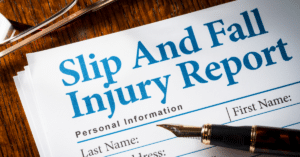
SLIP AND FALL
CHECKLIST
About Missouri’s Statute of Limitations for Slip & Fall Claims
In the civil setting, a statute of limitations begins to run from the date of injury. The Missouri personal injury statute of limitations are codified in the Missouri Revisor of Statutes. The purpose of a statute of limitations is to provide potential plaintiffs a clear picture of when they must assert their claims and to alleviate responsibility for potential defendants for actions or omissions that occur beyond the prescribed period.
The statute of limitations is dependent on where the injury occurred, what kind of claim you are bringing, and what kind of party you are bringing the claim against. Generally, negligence claims in Missouri include injuries resulting from injuries from slips, trips, and falls due to dangerous conditions on another’s property; injuries from dog bites; motor vehicle collisions; and most other injuries caused by an act or omission from a person or business. The statute of limitations for negligence claims in Missouri is five years from the date of injury, meaning if someone causes a dangerous condition that results in a fall causing injury to your person, you have five years to file a complaint (also known as a petition) in the Missouri courts. That does not mean that the case must be completed, verdict or settlement and all, before the end of five years.
In that same scenario, if the fall resulted in death to the injured party, then the injured party’s family has a right to a wrongful death claim against the defendant. This is a different type of claim than a negligence claim in that it is a claim that belongs to the deceased’s survivors who step in, not to the injured party. The statute of limitations for wrongful death in Missouri is three years rather than five years.
Note, however, that if someone is injured because of another’s negligence and then subsequently dies from unrelated causes, their statute of limitations remains five years, but they must have an estate filed within one year of the date of their death to pursue their negligence claim. The settlement from the negligence claim becomes property of the decedent’s estate.
When the defendant is a city or city entity, then the regular statute of limitation applies, however, the injured party must provide the relevant municipal entity 90 days’ notice of “the place where, the time when such injury was received, and the character and circumstances of the injury, and that the person so injured will claim damages therefore from such city.” Probably the most common examples of negligence stemming from a municipal defendant would be trips and falls on city sidewalks or car crashes with innocent bystanders in police chases. Other examples could arise from dangerous conditions from city utilities (digging in and around properties), dangerous conditions in city parks and playgrounds, or hazards caused by traveling in public transportation.
Comparative Negligence in Slip and Fall Cases
The personal injury statute of limitations in Missouri refers to time restrictions imposed for filing a civil lawsuit with a personal injury claim. A statute of limitations also exists at a state level for criminal charges.
For civil actions like personal injury and negligence claims, there is always a governing statute of limitations for each state. Depending on the type of injury and liable party, the statute of limitations may vary for different case types such as those that involve wrongful death, claims of medical malpractice, or workers’ compensation. The Missouri personal injury statute of limitations states that an individual has 5 years from the date an injury was discovered to pursue legal action.
Personal injury lawsuits are defined as an injury due to the negligence or intentional wrongdoing of another party, and lawsuits may be filed in Missouri’s civil court system.
If you or a loved one has suffered an injury due to someone else’s negligence or intentional wrongdoing, a personal injury lawyer can help you file a claim to recover compensation for damages such as medical bills, lost wages, and pain & suffering. In Missouri, personal injury claims may include car accidents, defective products, medical malpractice, or premises liability cases. For questions regarding the statute of limitations or Missouri personal injury lawsuits, contact a personal injury attorney for help.
Additional Legal Considerations for Slip and Fall Accidents
Premises liability cases look at the status of the injured party to determine the standard of care that the defendant owes the plaintiff. Defendants in premises actions may include the following:
- Owners of the premises
- Tenants or other occupiers of the premises
- Persons hired by the owner or occupier to maintain or repair the premises
- Contractors who are constructing or altering the premises
- Condominium associations
- Employers who fail to carry workers compensation insurance even if there is a “statutory employer” of the injured plaintiff worker
In many premises liability cases, there may be additional defendants who may be included because of negligence or product liability theories. Thus, an injured person may bring an action against a cleaning company which was under contract to keep the premises clear of debris, or against a person who assumed a duty of maintaining the property. However, a third person who has assumed no obligation regarding the condition of the premises which produced the plaintiff’s injury is not liable.
The common law of Missouri bases premises liability on the status of the injured entrant to the land, meaning if you are not on someone’s property but only adjacent to their property, you cannot sue them under premises liability. Premises liability cases divide plaintiffs in such cases into three broad classes: 1) trespassers, 2) licensees, and 3) invitees.
The status of the plaintiff as licensee, invitee, or trespasser is a question of law. The status of a plaintiff may change if the plaintiff strays from the scope of the invitation with which they entered upon the land. For example, if someone is invited to a farmhouse for a party but told to avoid the barn, they would be a licensee in the house but a trespasser if they entered the barn.
A trespasser is a person entering upon the premises without consent or privilege. The permission to enter may be expressed or implied.
Licensees enter with the consent of the owner or occupier, but for the licensees’ own purposes. A person may be a licensee if the owner or occupier has known of and acquiesced to repeated entries (e.g. where people regularly cross the land as a shortcut). A social guest is a licensee and not a separate class of entrant on land.
Invitees enter with consent and to the benefit of the owner or possessor of the premises. They often are called “business visitors.” An entrant becomes an invitee when the possessor of the premises issues an invitation in expectation of a material benefit from the visit or extends the invitation to the public generally. There is no requirement that a plaintiff actually complete a transaction on the premises to be an invitee. A common example would be guests of retail stores or restaurants.
Get Help From A Slip and Fall Lawyer at Brown & Crouppen Law Firm
If you or someone you love have been injured or has experienced symptoms after a slip and fall accident, you may be eligible to recover compensation for damages. Since 1979, the attorneys at Brown & Crouppen Law Firm have helped clients recover over $1 billion dollars as a result of settlements and verdicts, including individuals who have filed slip and fall claims.
Getting started with your slip and fall case is easy. Call us at 888-802-8156 for a free consultation, or tell us about your case online to get help from a Kansas City or St. Louis slip and fall attorney. And remember, there’s no upfront cost to you — if you don’t get paid, we don’t get paid.




